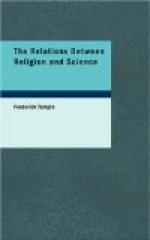It is, however, necessary to point out that when we speak of a breach of uniformity we are never in a position to deny that the breach of uniformity may be physical only and perhaps apparent only. It may be found, it probably will be found, at last that the Moral Law has in some way always maintained its own uniformity unbroken. The Moral Law has in its essence an elasticity which the physical law has not. It often takes the form, that, given certain conduct, there will follow certain consequences; and the law is kept though the conduct is free. It is further possible, and Revelation has no interest in denying it, that the intervention which has apparently disturbed the sequence of phenomena is, after all, that of a higher physical law as yet unknown. For instance, the miraculous healing of the sick may be no miracle in the strictest sense at all. It may be but an instance of the power of mind over body, a power which is undeniably not yet brought within the range of Science, and which nevertheless may be really within its domain. In other ways what seems to be miraculous may be simply unusual. And it must therefore be always remembered that Revelation is not bound by the scientific definition of a miracle, and that if all the miraculous events recorded in the Bible happened exactly as they are told, and if Science were some day able to show that they could be accounted for by natural causes working at the time in each case, this would not in any way affect their character, as regards the Revelation which they were worked to prove or of which they form a part. Revelation uses these events for its own purposes. Some of these events are spoken of as evidences of a divine mission. Some of them are substantive facts embraced in the message delivered. And if for these purposes they have served their turn, if they have arrested attention which would not otherwise have been arrested, if they have overcome prejudices, if they have compelled belief, the fact that they are afterwards discovered to be no breach of the law of uniformity has no bearing at all on the Revelation to which they belong. The miracle would in that case consist in the precise coincidence in time with the purpose which they served, or in the manner and degree in which they marked out the Man who wrought them from all other men, or in the foreshadowing of events which are in the distant future.




